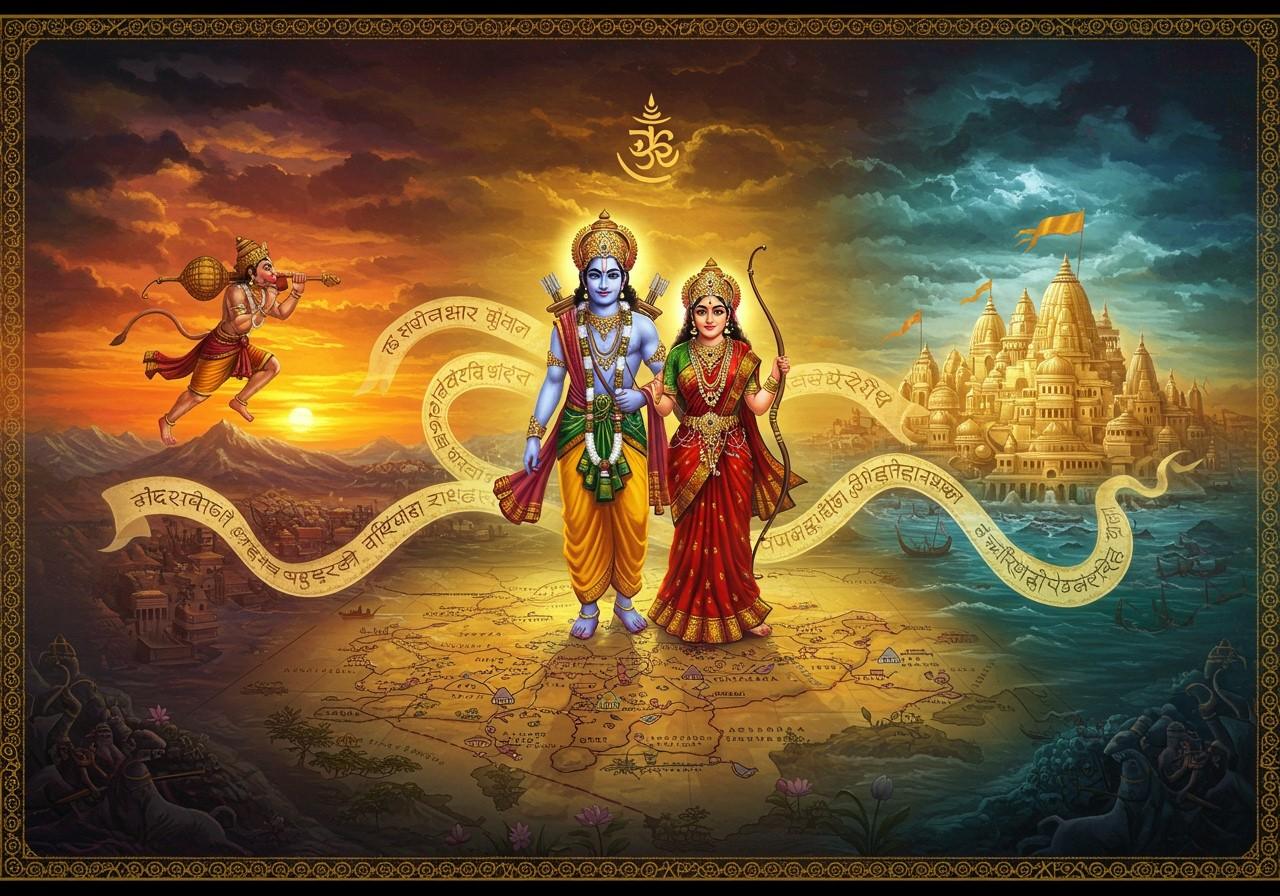
The Ramayana, a cornerstone of ancient Indian literature and one of the two major Sanskrit epics, narrates the captivating tale of Rama, the prince of Ayodhya. This blog delves into the timeline and geography of the Ramayana, providing insights into its historical and geographical contexts. By understanding when and where these pivotal events transpired, we can better grasp the epic’s significance and its enduring connection to Indian tradition and spirituality.
Historical Context of the Ramayana
Composed around the 5th century BCE by the sage Valmiki, the Ramayana consists of approximately 24,000 verses in Classical Sanskrit. The epic’s timeline is believed to date back almost 1.6 million years ago, placing it within the Treta Yuga, a significant era in Hindu cosmology. This dating, while seemingly distant, speaks to the timeless nature of the epic’s themes. Delve deeper into the authorship and origins of the Ramayana.
Key Events in the Ramayana
- Rama’s Birth: The epic commences with the auspicious birth of Rama in Ayodhya, setting the stage for his extraordinary journey. This event foreshadows the divine role Rama will play in upholding dharma.
- Exile: A pivotal turn in the narrative occurs when Rama, his devoted wife Sita, and his loyal brother Lakshmana are exiled to the forest for fourteen years. This exile tests their resilience, piety, and commitment to righteousness.
- Abduction of Sita: The narrative intensifies with the abduction of Sita by Ravana, the ten-headed demon king of Lanka. This act of treachery sets in motion a chain of events leading to a monumental clash between good and evil. Learn more about the key characters and the life lessons they embody.
- Victory and Return: After a fierce battle, Rama vanquishes Ravana, rescues Sita, and returns triumphantly to Ayodhya. This victory symbolizes the triumph of dharma over adharma and the restoration of balance and justice. Explore the theme of dharma in the Ramayana.
Geographical Context of the Ramayana
The Ramayana unfolds across a vast geographical canvas, spanning from the northern reaches of India to the southernmost tip. Key locations, each imbued with symbolic significance, include Ayodhya, Kishkindha, Lanka, and Chitrakoot. Discover the significance of the Rama Setu bridge.
Significant Locations
- Ayodhya: Revered as the birthplace and kingdom of Rama, Ayodhya represents righteousness, order, and ideal governance. Its sanctity is central to the narrative, symbolizing the values Rama fights to protect. Bring the divine presence of Lord Vishnu into your home with a beautifully crafted brass murti.
- Kishkindha: The kingdom of Sugriva, the monkey king, Kishkindha becomes a crucial ally in Rama’s quest to rescue Sita. It represents the importance of alliances and the power of collective action in overcoming adversity.
- Lanka: The island kingdom ruled by Ravana, Lanka symbolizes the forces of darkness and adharma. The battle fought here represents the eternal struggle between good and evil. Separate fact from fiction in the Ramayana’s historical narrative.
- Chitrakoot: A place of serene beauty where Rama, Sita, and Lakshmana spent a part of their exile, Chitrakoot symbolizes tranquility, spiritual retreat, and resilience amidst hardship.
Significance of the Timeline and Geography in the Ramayana
The timeline and geography of the Ramayana are not mere backdrops but integral elements that enhance our understanding of the epic’s profound meanings. The timeline underscores the cyclical nature of time and the importance of dharma in each era. The geographical locations, imbued with symbolic weight, enrich the narrative and deepen its spiritual resonance. Explore the cultural impact of the Ramayana across the ages.
The journey of Rama, Sita, and Lakshmana serves as a powerful metaphor for the individual’s spiritual journey, filled with trials, tribulations, and ultimately, triumph. The natural landscapes, from the serene forests to the treacherous oceans, mirror the internal struggles and external challenges faced by the characters. By understanding the timeline and geography, we gain a deeper appreciation for the epic’s enduring legacy and the timeless wisdom it imparts. Discover timeless lessons from the Ramayana for modern life.
Poojn.in: Your Spiritual Companion
At Poojn.in, India’s leading online store for cultural and spiritual goods, we offer a wide selection of products to enhance your connection to the Ramayana. Explore our collection of Rama Namavali and other sacred items. We also provide resources and insights to deepen your understanding of this epic tale. Learn about Ramayana festivals and how to celebrate them. Enhance your spiritual practice with a Tulsi Kanthi Mala.
Conclusion
The Ramayana’s timeline and geography are not mere historical and geographical details; they are interwoven with the epic’s spiritual and philosophical core. They provide a framework for understanding the characters’ journeys, the symbolic significance of events, and the timeless values the epic espouses. By exploring these dimensions, we gain a richer, more nuanced appreciation for the Ramayana’s enduring power and its continued relevance in our lives today.

